“Pre-existing conditions” is a term we all became familiar with during the COVID-19 pandemic.
Those living with a pre-existing condition are at a higher risk of developing complications. The good news is that many health conditions can be detected early — and sometimes avoided entirely — thanks to a few periodic health screenings.
If you’re at risk for a health condition such as diabetes, high blood pressure or cancer, early intervention could improve your health. But to achieve the best possible outcome, in most cases, this means detecting the problem before any symptoms.
That’s where screenings come in, and now’s the time to get that screening you may have put off last year.
Health Screenings: What to Expect
Most health screenings, which are generally administered during an annual preventive visit with your primary care provider, are quick, non-invasive tests that can be performed in your provider’s office. Some involve a small blood draw, a physical touch or technological instrumentation. But even the mildest discomfort is worth the peace of mind of catching a health threat early before it becomes a problem.
Factors That Influence Your Health Screening Recommendations
The recommended screenings vary based on your gender, age, and your family health history. If your mother or father were diabetic, for example, you run a higher risk of developing diabetes even if you maintain a healthy diet and have no symptoms of diabetes.
It’s important to talk to your primary care provider about your health history and risk factors, so that he or she may advise you on the appropriate schedule for your screenings.
With that in mind, here are some general guidelines on the most common screenings, listed by the conditions they are designed to detect.
Diabetes Screening
According to the American Diabetes Association, diabetes and prediabetes affect more than 100 million American adults and nearly 3 million Texans. And roughly 24 percent don’t even know they have it. There are several tests your provider might use to screen for diabetes, but they are all designed to measure the amount of sugar in your blood. Results are usually available quickly. You may be asked to fast for up to 12 hours prior to your diabetes screening.
The current recommendation is for screenings to start at 35 years old, however, if you are at a higher-risk of developing diabetes, your doctor may like you to start screening sooner. Our short 5-minute assessment will help you understand your chances for developing diabetes and learn how to improve risk factors.

Cholesterol and Blood Pressure Screenings
Because high cholesterol and high blood pressure are underlying risk factors linked to so many chronic (and even fatal) health conditions, checking them regularly and controlling them with medication (if necessary) are simple steps that can help men and women avoid many unwanted health issues.
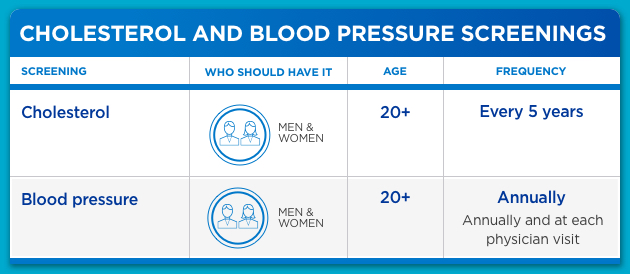
Colorectal Cancer Screening
According to the CDC, colorectal cancer almost always develops from precancerous polyps (abnormal growths) in the colon or rectum. These polyps can generally be easily detected in a regular screening, which is recommended for all adults in the 45-75 age range. Historically, the majority of colorectal cancer cases have occurred in people who are 50 or older, but the US Preventive Services Task Forcerecently changed their recommended screening guidelines to begin screenings at age 45 due to an increase in cases among younger adults in recent years. Regular screenings are key to the prevention and early detection of colorectal cancer.
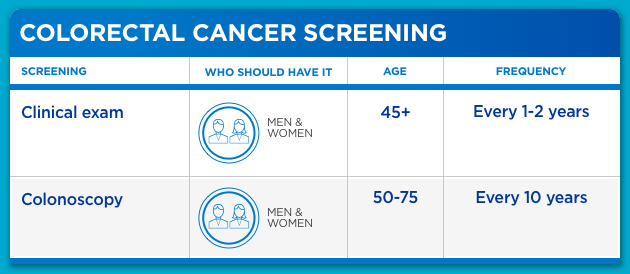
Cervical Cancer Screening
There are two screenings that can help with early detection of cervical cancer: a pap smear and a human papillomavirus (HPV) test. Pap smears look for precancerous cells that, if left untreated, could become cancerous. The HPV test looks for the actual virus that causes the cells to change.
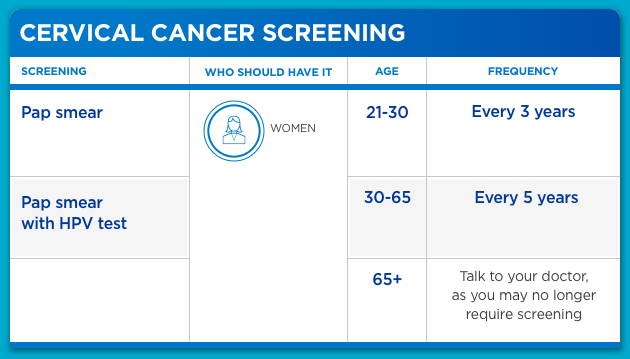
Breast Cancer Screening
Women at average risk for breast cancer should start annual mammograms at age 40 and continue through age 74.
Women who have an increased risk for breast cancer due to family history, a known BRCA1 or BRCA2 gene mutation or other risk factors should discuss screening options with their physician. If you have risk factors, together with your physician you can decide what’s best for you.
If you find a lump or something that worries you, schedule an appointment with your physician, but don't panic — eight out of 10 lumps are not cancer. Your physician can write an order to schedule your diagnostic mammogram.
Mammography is your best defense against breast cancer because it can detect the disease in its early stages, before a lump can be felt during a breast exam.
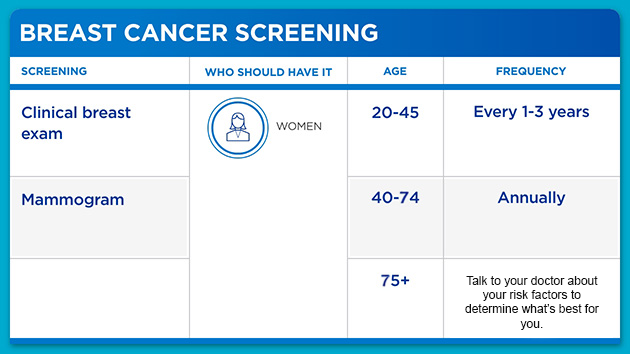
Skin Cancer Screening
Like breast exams for women, skin cancer screenings begin at home with routine self-exams. Discovery of any abnormalities such as moles that have grown or changed in size, color or symmetry, should be reported to a provider immediately.
During a clinical exam, the provider will check for moles, birthmarks and other pigmented areas that look abnormal. If there is an area on the skin that appears abnormal, the provider can perform a biopsy and send the tissue sample to a lab to check for the existence of cancerous cells.
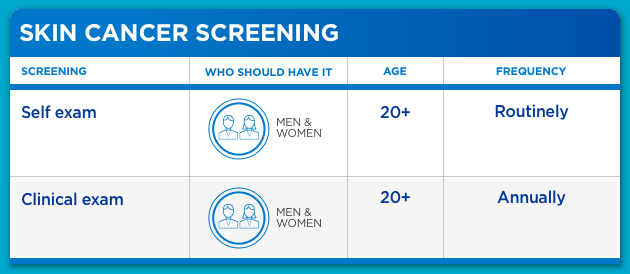
Prostate Cancer Screening
There are two different types of prostate screenings: the Prostate Specific Antigen (PSA) Test and the Digital Rectal Examination (DRE). The PSA test measures PSA levels (a substance made by the prostate) in the blood. Elevated PSA levels could indicate a problem with the prostate.
A provider administering a DRE test will insert a gloved and lubricated finger into the male’s rectum to feel the prostate for any abnormalities, such as an enlarged prostate. Because prostate cancer is most likely to develop in men over the age of 55, it is recommended that men should consider more frequent prostate cancer screenings between the ages of 55-69.
Osteoporosis Screening
According to the National Osteoporosis Foundation, a bone density screening is the only way to detect osteoporosis before a broken bone occurs. A bone density test, also known as a bone mass measurement test, can tell you if you have normal bone density, low bone density or osteoporosis.
Lower bone density means there is an increased risk for a potential broken bone. Checking for bone density is important for both men and women after a certain age. For some, depending on risk factors, it might be important to begin screenings earlier. Your provider can recommend the right screening frequency based on your individual risk factors.
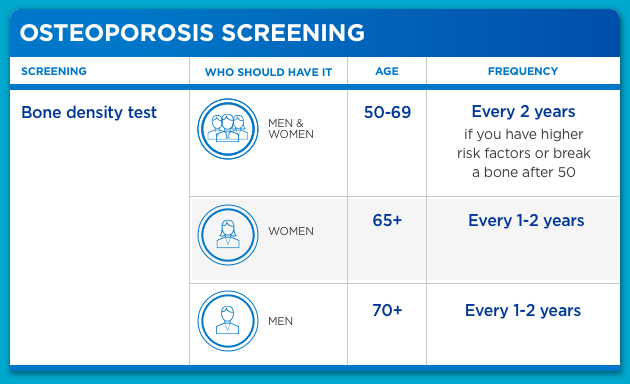
Abdominal Aortic Aneurysm Screening
An abdominal aortic aneurysm is a dangerous enlargement of the largest artery in the body, the aorta. It is a slow-growing and symptomless condition that can be fatal. Abdominal aortic aneurysms can be detected through a few methods of screening: abdominal ultrasounds, CT scans or MRIs. These tests are especially important for men who smoke or were smokers at one time. Men over the age of 65 who have never smoked should consult their provider, as this exam may not be necessary.
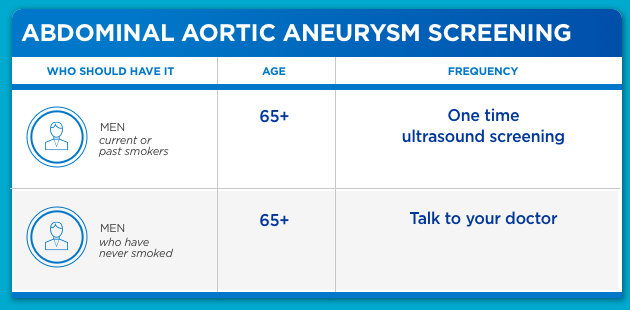
Lung Cancer Screenings
Lung cancer screenings are performed via low-dose CT (LDCT) scan and used to detect cancerous growths mainly in individuals who are at higher risk due to a history of smoking. It is recommended these individuals have an annual LDCT exam:
- Age 50-80
- No signs or symptoms of lung cancer
- Tobacco smoking history of at least 20 pack-years
- Current or former smoker or one who has quit smoking within the last 15 years

Hearing Tests
Hearing loss is very common in older adults. In fact, it is estimated that one-third of adults over the age of 65 have experienced some loss of hearing.
People who have trouble hearing high-pitched sounds, TV shows or conversations with others should have their hearing checked once every ten years through age 65, and possibly as frequently as every three years after that.
Here are several types of hearing tests, but most tests check your responses to tones or words in different pitches and volumes.
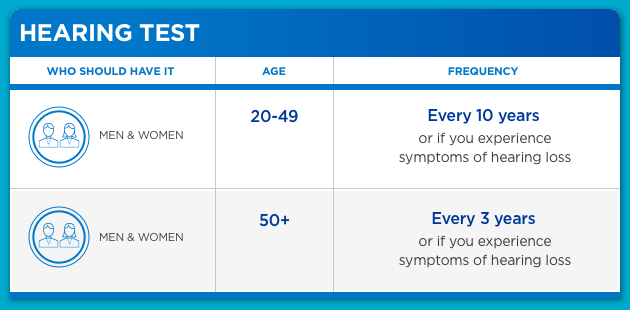
Immunizations
You might think of immunizations and booster shots as something your pediatrician gave you back in grade school, but the fact is that adults also require some periodic vaccinations. Some of the vaccines you likely received as a child will also lose their efficacy over time, necessitating periodic booster shots.
Here are the current recommendations for vaccinations for most adults.
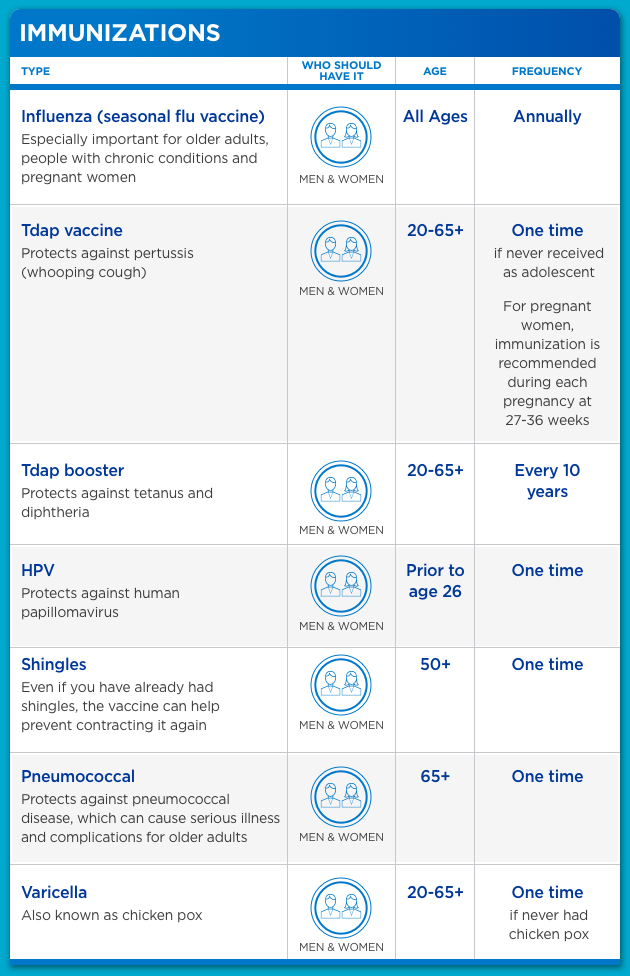
Reminder
Recommended screenings may vary based on your individual risk factors and family history. Talk to your provider about which screenings you should have, and how frequently you should have them. If you skipped your annual check-up last year, it’s even important to see your provider this year so you can rest assured your health is taken care of.
Finding a physician who can partner with you for your health is essential. We can help find a physician that’s appropriate and convenient for you. Call 1-877-THR-WELL (847-9355) or visit TexasHealth.org/FindaProvider today.
Sources: Centers for Disease Control & Prevention (CDC), Johns Hopkins Medicine, National Osteoporosis Foundation,
National Library of Medicine, U.S. Preventive Services Task Force

